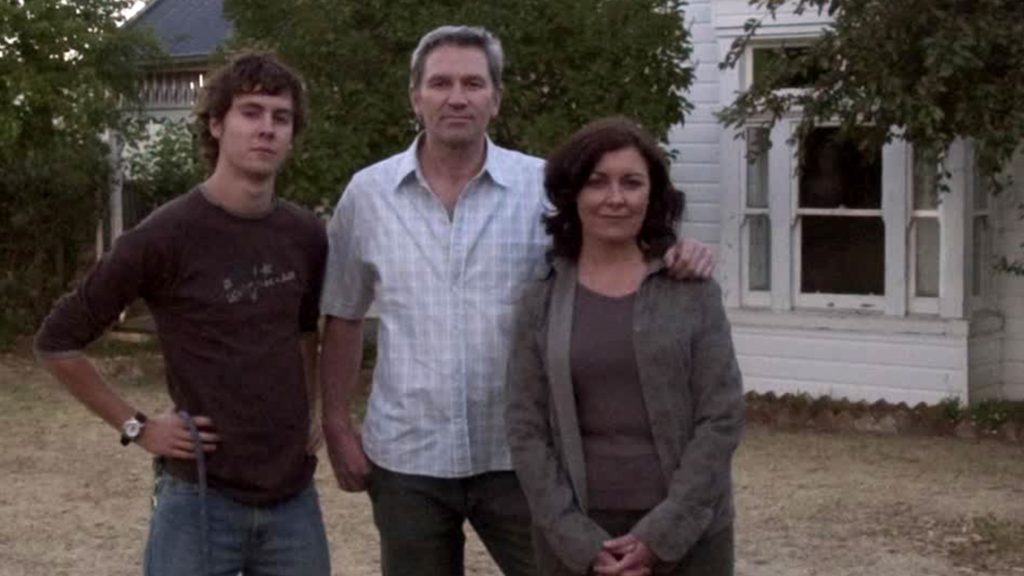Lake Mungo
2008

Rating: R
Genre: Drama, Horror, Pseudo-Documentary
Country: Australia
Run-Time: 1h 27min
Director: Joel Anderson
Cast
Rosie Traynor…………..June Palmer
David Pledger………….Russell Palmer
Matin Sharpe……………Mathew Palmer
Can a movie be really, REALLY scary without jump scares- or at least the possibility of jump scares? My honest answer: “no”…not really. Don’t get me wrong, I love atmospheric horrors. Most of the films listed on the Midnight Selections are atmospheric horrors. But the scariest films don’t rely on atmosphere alone. Sure, you can argue- as so many people do- that The Witch or Hereditary are scarier films than Sinister, but I think in your heart you know that’s not true. Now, if you want to argue that they are better movies, I’ll probably hop on board. But scarier? Really?
Online, I often read people claim that horror movies don’t need jump scares to effectively scare people or that somehow jump scares aren’t scary at all. And every time I read these statements, I always assume that person is in denial and wonder which jump scare from the past traumatized them.
Personally, I think the anticipation that comes before a well-crafted jump scare is one of scariest things you can put in a movie. Sure, I’ll agree that there are a lot of movies with jump scares that are not scary; but to try to have a scary film without one is unlikely.
So why do I bring up jump scares when talking about Lake Mungo, a simple low-budget Australian indie flick that is- almost- entirely devoid of jump scares. Because, put plainly, there is an incredible amount of people out there- people who do come across as having an anti-jump scare agenda, that will tell you that Lake Mungo is amongst the most terrifying films ever made. And I am one of them. In fact, I would even argue that Lake Mungo is the scariest “unscary” movie ever made. It is the exception to my scary-movies-need-jump-scares rule. And if you don’t believe me, then watch it late at night, credits and all. (Good god, watch the credits!) Think to afterwards, as so many of us have, that “That wasn’t that scary” and question its hype.
Then try to go to sleep.
For those who have never heard of it, Lake Mungo is a pseudo-documentary and the debut feature by Joel Anderson. It follows the case of the Palmer family (the Twin Peaks reference is intentional) as they cope with the drowning and subsequent re-sightings of their teenage daughter Anna.
At Lake Mungo’s core, it is a film about grief. Each of the Palmers adjust to the loss of Anna in a different way and the film does a good job exploring Anna’s previous relationship to each of them. Anna’s father, Russell, takes refuge by throwing himself into his work. Her brother Mathew begins expressing his grief through a series of increasingly bizarre photos. And her mother June has started trespassing into the neighbour’s homes at night to “feel like someone else” for a while. It is all very heartbreaking.
But the story is also one of mystery, especially after sightings of Anna spread to others in the neighbourhood. Are people really catching Anna’s ghost on tape and in photos? If not, what are they capturing? Eventually, the pursuit of answers begins uncovering dark secrets from Anna’s past.
Anderson does a good job unravelling the films many plot threads. Like a real investigative documentary, the plot moves forward in one direction only to have a new revelation turn it in another. Interestingly, Anderson restrains himself from having his fictional documentary crew reveal themselves, which is a real rarity in horrors that utilize this format, adding to the film’s overall feeling of authenticity. And the acting in Lake Mungo is top notch. In fact, I’ve read of people successfully tricking friends watching Lake Mungo under the pretense that it really is a documentary. It is a mean trick, but if any horror film is going to fool people into believing its real, this is the one.
Yes, Lake Mungo does have one jump scare…and yes, it is chillingly effective, but more because of the implications of that jump scare instead of the scare itself. It is the kind of otherworldly encounter that would rock any of us to our core- like seeing your face on a giant hanging balloon. (I’ve been reading a lot of Junji Ito lately. If you don’t know, I suggest you look up the reference.) My point is that watching Lake Mungo is genuinely terrifying experience, and it doesn’t need its jump scare to accomplish this. This is a film that tells a ghost story…and includes a genius end credits gimmick…that is more than enough substance to rattle you.
Ironically, part of the reason this film scares so well is because it isn’t out to tell us a tale about a ghost was malicious intent; it simply tells a story that feels so genuine that it will cause even the most sceptical to, at least for one night, believe that in the existence of ghosts exist and start looking for them once lights go out.
In my mind, Lake Mungo is the single most underappreciated horror film in the last three decades, and I get that because it comes across as unassuming and unintentionally subversive. Hell, its horror story even plays second fiddle to its tale of grief. Yet, there is a hypnotic power to this story, as well as a circular logic that adds an extra level of chills after its final reveal. There is a reason why even today, Lake Mungo continues to enter horror conversations about hidden gems and scary films. Though few have seen it, it has left a strong impression on many who have. It offers up a truly unique film experience.
No other film creates horror in the same way Lake Mungo does. And he accomplishes it with so little. Lake Mungo has little in the way of effects. Yet, somehow, it all works to make for an unsettling experience. This is horror storytelling at its finest. Aspiring filmmakers need to pay attention!!!
And for the love of God, stay for the credits!
